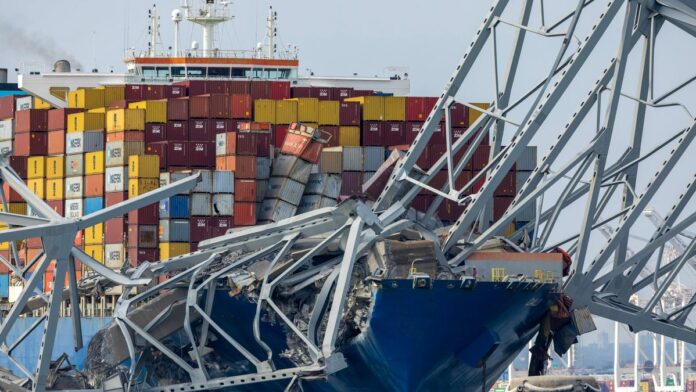The Francis Scott Key Bridge in Baltimore, Maryland collapsed early Tuesday morning after the cargo ship the MV Dali collided with one of the bridge’s support pylons. Now, reports from the National Transportation Safety Board have confirmed that 56 containers on that ship were carrying hazardous material. Some of those containers have been breached, while others have fallen into the water, Business Insider reports.
NTSB Chairperson Jennifer Homendy confirmed to reporters that a senior hazmat investigator boarded the ship and confirmed that 764 tons of hazardous material was on the ship at the time of the crash. These containers have included everything from “corrosives, flammables and some miscellaneous hazardous materials” to “class nine” materials, which could include lithium-ion batteries. However, the NTSB has not yet been able to confirm the exact kinds of hazardous materials onboard the ship, nor has it been able to pinpoint the kinds or amounts of materials that may have leached into the water of the Patapsco River.
Because it’s still not clear what materials are involved, it is currently impossible to speculate on what kind of risk, if any, will be posed to the public. Officials have “seen sheen on the waterway,” Homendy said. It is not clear what substance is causing that sheen.
While 764 tons of hazardous material may sound like a lot, the Dali itself was carrying around 95,000 tons of cargo at the time of its crash on Tuesday morning. The Key Bridge collapse has not been declared a chemical-related emergency, however, that could change as we receive more information regarding the hazardous materials onboard the ship. The potential presence of hazardous materials has already limited NTSB access to certain areas of the ship.
The full impact of the Key Bridge collapse is not yet clear, but we can expect it to be significant. The Port of Baltimore is the ninth busiest port in the United States for international cargo, and it’s a significant hub for the automotive trade. That port has been closed for the foreseeable future as search, rescue, investigative, and clean-up operations get underway. Homendy estimates that the full investigation into the ship’s malfunctions could take between 12 and 24 months, but that does not account for any additional time that may be needed for reconstruction or clean-up.
A version of this article originally appeared on Jalopnik.


